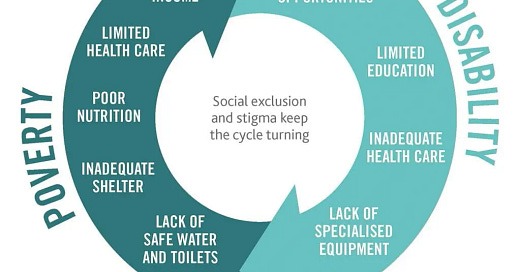Ten Ways You Can Fight Ableism, Break the Disability Poverty Cycle, and Support People with Disabilities
Breaking the disability poverty cycle requires enforcing accessibility laws and breaking down barriers to education, employment and full participation in society.
Understanding the Disability Poverty Cycle
The idea is simple: disability leads to poverty, and poverty leads to disability, with each side fuelling the cycle, potentially worsening both disability and poverty over time.
What is Ableism?
Ableism is discrimination and oppression against disabled people. Oppression refers to the use of power by one group to disempower, marginalize, or exert dominance over another group. Dominant groups can maintain their status, privilege, and power over others intentionally and unintentionally, as well as in obvious and subtle ways. Acts of oppression can become institutionalized or systemic as a form of structural violence, thus becoming hidden and seemingly ‘normal.’ Acts of oppression can also play out on the personal and interpersonal levels, influencing individual values, beliefs, actions and interactions between people.
Ten Ways You Can Support People with Disabilities and Fight Ableism
1. Learn to identify and eliminate physical and attitudinal barriers.
Physical barriers are objects or structures that prevent or block mobility and access.
Attitudinal barriers are negative attitudes and stereotypes about disability that contribute to dehumanization and exclusion.
2. Plan nothing about us without us. Disability inclusion planning should always include disabled people and center around their lived experiences.
3. Consider disability needs in construction planning, content creation and public/workplace access for all activities and events.
Plan parking and space adequate for wheelchair-accessible vehicles, ensure all doorways, corridors, and washrooms are wheelchair accessible and provide low-angle ramps, elevators and wheelchair-accessible seating areas with clear signage for all wheelchair users.
Use braille, spoken language directions or large high-contrast symbols. Make internet content accessible through high-contrast text options, alt-image descriptions, and camel case on hashtags for vision-impaired employees and visitors.
Provide clear signage, closed captioned media, sign language and visual cues for hearing-impaired employees and visitors.
Provide quiet, warmly lit, calming areas for visitors with anxiety or stress disorders, sensory integration challenges, or heightened sensitivity to light, sound or touch.
Ensure emergency systems include auditory and visual cues and that emergency exits and adjacent areas have clear signage and are fully accessible.
4. Make it safe to disclose a disability. While disclosing disability is supposed to carry the benefit of creating accommodation and inclusion opportunities, many people with disabilities have learned from experience that they will be discriminated against or stigmatized and will attempt to hide their disability and accommodation needs.
5. Implement inclusive laws, policies, and practices.
Make justice accessible in Canada by making ableism a hate crime. Human rights and disability inclusion laws are ineffective because enforcement is poor, not all courts are accessible, and civil law is cost-prohibitive. Ableist oppression and marginalization thrive in Canada because law enforcement and justice are inaccessible to those most vulnerable.
Develop Inclusive hiring and interviewing practices. This means being transparent, defining company values and backing inclusivity initiatives with resources, time, energy, money, and decision-making power.
Design inclusive workplace environments that use accessible planning and design created with direct input and collaboration from members of the disability community.
Develop easy-to-use, non-judgemental accommodation procedures, supportive medical leave and return-to-work policies/practices and performance management practices in direct collaboration with members of the disability community.
Use disability training companies run by disabled people to provide workplace-wide disability and anti-ableism training.
6. Be aware of your language. Please don't use terms with negative connotations or disrespect. Such terms include crippled, abnormality, retarded, and dummy. Do not refer to abled people as normal. Avoid using disability terms as adjectives to describe a person without a disability. For example, don’t call someone OCD to imply that they are extremely detail-oriented or methodical.
7. Make disability inclusion intersectional. A person’s race, gender identity, sexual orientation, nationality, socio-economic status, etc., all influence how they experience disability.
8. Treat people with disabilities as equals. You should always assume intelligence and capacity. Talk to the person, not over or around them. When addressing a disabled person, you should speak to them, not their friend, caregiver, aide, or interpreter. Use the same tone of voice you would use with anyone else. Do not use baby talk or adapt your tone of voice to connote concern or encouragement.
9. Support positive disability representation in content creation and media. Accurate, authentic, and diversified disability representation is necessary to overcome stereotypes. Storylines should portray disabled people as the multidimensional and whole people they are versus focusing on their disability. Narratives should not follow common stigmatizing tropes such as disabled people “overcoming” their disability or teaching abled people a lesson about being grateful for what they have. Authentic representation also includes rejecting abled actors from portraying people with disabilities.
10. Learn about the history of disability rights. People with disabilities have long been wrongly considered helpless, unproductive citizens who burden society. Unfortunately, due to lax enforcement, oppressive ableist and eugenic attitudes continue to be a problem despite human rights and inclusion legislation designed to address it.
Please join the movement to change these attitudes and build an inclusive society. Together, we can make a difference, and we will all benefit from including this very large and capable, but overlooked segment of our population.





